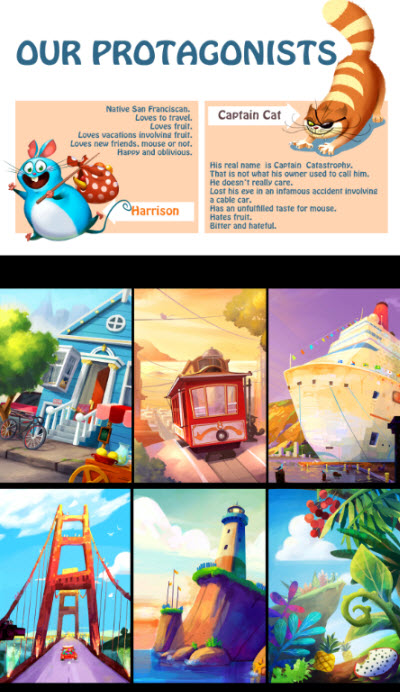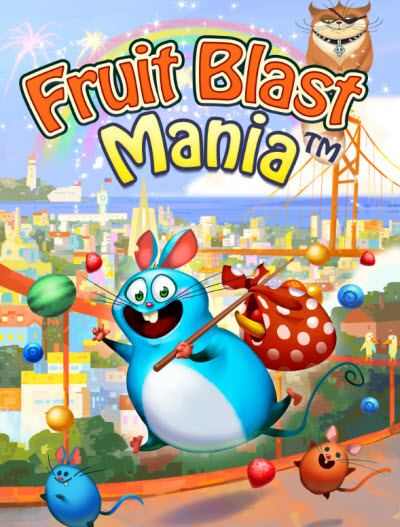The crazy competition of the mobile gaming market can make a chief executive panic. Huge brands like Disney are invading the market. Mobile messaging services are creating kings in the Asian gaming market. The odds of people finding your game in the app stores are getting worse as more titles flood the market, and it isn’t easy to predict what will make gamers go nuts.
But Perry Tam is staying calm. The chief executive of Redwood City, Calif.-based social mobile game publisher Storm8 has grown his company organically. Founded in 2009 by Tam and other former Facebook employees, Storm8 has had more than 400 million downloads to date, and it boasts more than 10 million players who come back to its games every day on iOS and Android. Its titles are home-grown social casual games such as Pet Shop Story, iMobsters, and Slots.
Today, the company is launching a new title called Fruit Blast Mania, a social arcade game with a tile-matching gameplay mechanic. From the company’s TeamLava studio, Fruit Blast Mania is typical of Storm8. It’s not particularly creative, as it is a mashup of some familiar titles. But it is completely homegrown and aimed at getting casual players to engage with it in a deep way. The title has hundreds of levels where players burst fruit clusters with their fingers. How does the company pump these titles out and compete with huge rivals?
We caught up with Tam last week at our Mobile Summit event in Sausalito, Calif. Here’s an edited transcription of our interview.
GamesBeat: Did you get any general impressions from the Game Developers Conference, like a high-level view of what’s happening?
Perry Tam: I spent most of my time in meetings, so I didn’t spend much time getting to look at other people’s sessions, but I’ll certainly do that at the Vault when they publish the talks. I talked about how we bootstrapped the company from zero to 10 million daily active users, and our perspective on mobile gaming in general. The message was well-received, I think. People seem to be excited about mobile gaming.
GamesBeat: It’s interesting how you got there organically, or at least relatively organically. A lot more of that’s happening through acquisition or fundraising. It’s becoming a more complex business. It’s a lot harder to do it the way you guys did. Do you still feel like organic is the way to go, even if you’re starting out today?
Tam: As a growing company, we constantly assess our opportunities. We have been growing the company organically over the past four years, and I think that’s certainly a good way to do it. When we started we had this mindset of building a sustainable business. That’s what we’ve done, and mainly by finding good ways to invest our time and energy. We built up our own mobile network. That’s the core of the company. We’re always finding ways to bring people in the network.
But we always assess our options. There are many ways to grow a company. Different companies find different methods based on their culture and their strategy. For us, organic growth is a viable method, even now.
GamesBeat: How do you describe the environment as far as the pace of change now? How do you absorb some of these things that are happening? Like, supposedly Supercell is bringing money in through this $800 million valuation. Gung Ho, with Puzzle & Dragons, just got money from Softbank. Those guys seem to be getting that money because they’re the leaders of the day. How do you assess that?
Tam: First of all, all that is really good news. It’s good news for those companies and good news for the general market. It boils down to, what those numbers really say is that mobile gaming is a viable business. Those two companies are very successful. You might even call them outliers, but the fact that they can achieve that has set a high bar for the industry.
In 2011 we announced that we could make more than $1 million in revenue in a single day. That set the bar for everyone. Now there’s a new high mark. That’s great for everyone. Going back to where Storm8 fits into this whole picture, we believe that this is a huge business. We believed that four years ago and we believe it today. We want to build the biggest social gaming network on mobile. The way we did that is through games.
Having this sustainable model is very important to us. We don’t want to be a one-hit wonder. We have games in five different genres. We’re branching out and expanding our network. Again, that goes to the core of the company, building up this mobile social network. We do it by making different types of games, because the market is big enough that many different people want to come in and play games. You need a very wide spectrum in your portfolio.
 GamesBeat: You have the good fortune now of having teams that have done this a long time. How do those teams operate these days? Does a 10-person team work for a year now to do a game for you, or do you tend to reassign people a lot and have them start new things?
GamesBeat: You have the good fortune now of having teams that have done this a long time. How do those teams operate these days? Does a 10-person team work for a year now to do a game for you, or do you tend to reassign people a lot and have them start new things?
Tam: Working at Storm8 is like working in a big family. You don’t really get assigned to just one thing. People wear multiple hats. We have a platform mentality, where over the years we’ve built a lot of good technology within the company. We’ve built multiple engines that allow us to create games more rapidly. We’ve built up an analytics layer for ourselves that let us do A/B testing and optimization in real time. We also spend time on building up a better process for creating mobile games, from conception to submitting the app to getting the app to our users.
When someone comes to Storm8 to work on a game, they’re also working on all of those layers – the platform layers, the process layers – so they can contribute not just to one game, but to work that might be touching multiple genres or multiple games. That’s how we structure the company and the teams. Nobody’s stuck working on one game or one type of game.
GamesBeat: Are you relying on third parties now for anything, or are you building most things yourselves? What do you think of some of these external things, like Unity or even the Unreal engine?
Tam: When we started early in 2009, there weren’t that many tools to leverage. We ended up building a lot of technology in-house. Unity and Unreal are definitely great technologies for the mobile community. I wish we’d had something like that back in 2009. It would have cut a lot of time out of development. But the good thing about not having them at the beginning, it forced us to look into building our own stuff, and so we have a bit more leverage over our own destiny. We don’t need to wait for someone to work on the engine in order for us to do something. We can just go in and do it ourselves. So there are pluses and minuses in both cases.
GamesBeat: Have you guys looked heavily into 3D? Do you think 3D is going to be more important than 2D at some point?
Tam: It’s more that you have to look at the game holistically. You can’t just say, “3D is better than 2D” or vice versa. It has to do with what the game is about, what audience you’re talking to, and what fits into your game design.
GamesBeat: It always seems like scarier and scarier competitors are coming into the space. EA’s doing things like Real Racing and The Simpsons. They’ve been there all along, but there are more people flexing bigger muscles. How do you stay ahead of them?
Tam: It’s funny that you bring it up, because I mentioned this in my talk. When we started, we were a relatively small team. Smartphones weren’t well-known. People didn’t know that the smartphone ecosystem would get that big. In 2010 and 2011, we saw a lot of big successes on mobile. Rovio had Angry Birds. You had billions of actions in ngmoco’s games. They got a lot of traction and drew in a lot of big players, including VCs and the big publishers. There was something like $3 billion worth of acquisitions around that time. The bar for competition started rising and kept rising. We got more sophisticated people coming into the market.
That’s okay for us. When we reach back to our roots and think about what we’re trying to achieve, it reminds us that we’re trying to win in mobile. That’s how we became as big as we are today. To answer your question as far as how we stay ahead of the game, how we compete with all these sophisticated competitors, I explained in my talk that there are three keys to mobile success. First, time to market is very important. Mobile is very fast. Limit your development cycle. Make sure it’s quick. It goes back to how we perfect our processes for delivering games, from conception to launch.
Second is building a network. It’s important to aim for being more than a one-hit wonder. When we enter into a genre, we aim for multiple games in that genre and multiple successes. We don’t just want that one game. You build a network based on that. If you think of how to make multiple games, that builds up the user base that you can leverage.
The last thing is being bold. There’s a lot of opportunity in the mobile space. It’s relatively new. The smartphone has only been around four years at the most. There are lots of new innovations that you can discover and test. We’ve tried many new things over the years. We were among the first to get into the iOS the first getting into Android and Amazon. We were a launch partner with Facebook on the mobile web initiative. We were a launch partner with Apple on the Game Center. Some of those innovations work and some of them don’t, but when they work you have the early mover advantage. Those three keys are very important for anyone to be successful in mobile.


